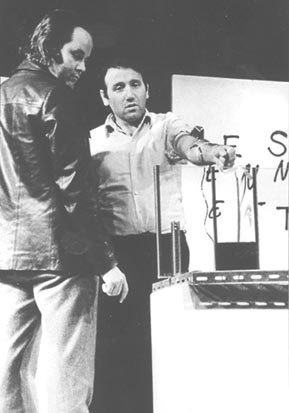vers & vernunft - Zeitblut, 1978 S/W Dokumentationsfotografie einer Performance in Stichting de Appel, Amsterdam Peter Weibel das offene werk 1964 - 1979 Click for English text Der Schwerpunkt der Ausstellung liegt auf dem 25-jährigen Frühwerk von Peter Weibel von 1964 bis 1979. Die künstlerische Entwicklung des Werkes von Peter Weibel als international anerkannter Medienkünstler und Konzeptkünstler soll von seinen Anfängen bis zur Mitte seines Werkverlaufs nachgezeichnet werden. Er hat als visueller Poet 1964 begonnen und bald die Strukturen der visuellen Kultur von der Seite auf den Bildschirm übertragen und gleichzeitig dabei das Modell der Sprache als Modell der Wahrnehmung im Sinne strukturalistischer und post-strukturalistischer Methoden beibehalten. Durch diese linguistische Fundierung seiner visuellen medialen Arbeiten entwickelte er einen kritischen Impuls, der sich nicht nur gegen die Kunst, sondern auch gegen die Gesellschaft und die Medien selbst wandte. Diese präzise Entwicklung von der Seite über den Bildschirm zum Galerieraum - alles bereits in den 1960er Jahren - hat viele Tendenzen dessen vorweggenommen, was später als Konzeptkunst, Kontextkunst, institutionelle Kritik, Intervention bezeichnet wurde. In seinem Werk, das ab 1966 bereits partizipatorische und interaktive Praktiken anwandte, die zu Closed-circuit-Videoinstallationen Anfang der 1970er Jahre und den ersten interaktiven Computerinstallationen 1980 führten, bereitet sich stringent wie in sonst keinem anderen der performative Turn vom geschlossenen Objekt der Moderne zu den offenen Handlungsfeldern der 2. Moderne oder Nachmoderne vor. Sein Werk ist geprägt nicht durch autobiographische Signatur, sondern durch Themenfelder und Problemzonen wie die Mechanismen der Wahrnehmung und des Denkens, die Eigenwelt der Apparatewelt, die Krise der Repräsentation, des Bildes und des Museums, die Beziehung von Kunst, Politik und Ökonomie, die Bedingungen des Betriebssystems Kunst. Daraus ergibt sich ein Werk, das in der Pluralität seiner Methodik und in der Kohärenz seiner Problemstellung den Entwurf eines neuen Werk- und Künstlerbegriffs in seltener Radikalität vorlegt, das nicht nur jetzt bereits viele junge Künstler beeinflusst hat, sondern auch noch im kommenden Jahrhundert es tun wird. Zur Ausstellung erscheint ein Katalog im Hatje Cantz Verlag mit Texten von Hans Belting, Ursula Frohne, Boris Groys, Günther Holler-Schuster, Brigitte Huck, Michel Regis und Siegfried Zielinsky (Hg. Christa Steinle, Karin Buol-Wischenau) Kuratoren: Günther Holler-Schuster, Peter Peer Ausstellungsdauer: 24.9. - 21.11.2004 Öffnungszeiten: Di-So 10 - 18 Uhr, Do 10 - 20 Uhr Neue Galerie am Landesmuseum Joanneum (1. und 2. Stock) Sackstrasse 16 A-8010 Graz Telefon +43 0316 / 829 155 Fax +43 0316 / 815 401 Email neuegalerie@stmk.gv.at www.neuegalerie.at Peter Weibel the open work 1964 - 1979 The exhibition focuses on the 25 years of Peter Weibel's early work from 1964 to 1979. The aim is to trace Peter Weibel's artistic development as an internationally renowned media artist and conceptual artist from the beginnings through to the middle phase of the course of his work. He started out in 1964 as a visual poet and was soon transferring the structures of the visual culture from the page to the screen, at the same time retaining the model of language as a model of perception in the sense of structuralist and post-structuralist methods. Thanks to this linguistic input into his visual media works, he developed a critical impulse that turned not only against art but also against society and the media itself. This specific development from the page via the screen to gallery space - all happening as early as the 1960s - anticipated many of the trends that were later to be described as concept art, context art, institutional criticism and intervention. In 1966 his work had already applied the participatory and interactive practices that led to the closed circuit video installations of the 1970s and the first interactive computer installations in 1980. As no other, it rigorously opens up the way for the performative turn of the closed object of modernism towards the open fields of action of the second modernism or post-modernism. His work is not determined by autobiographical signature but instead by thematic areas and problem zones such as the mechanisms of perception and of thinking, the private world of the world of machines, the crisis in representation, in the image and the museum, the relationship between art, politics and the economy, the conditions underlying the system by which art operates. The result is a body of works whose plurality of method and coherence of issues produce the framework for a new concept of work and artist with a rare radicality. It has already influenced many young artists, and its impact is set to continue in the coming century. A catalogue published by Hatje Cantz accompanies the exhibition. It includes texts by Hans Belting, Ursula Frohne, Boris Groys, Günther Holler-Schuster, Brigitte Huck, Michel Regis and Siegfried Zielinsky (editors Christa Steinle, Karin Buol-Wischenau). Curators: Günther Holler-Schuster, Peter Peer 24 September - 21 November 2004 |
|
